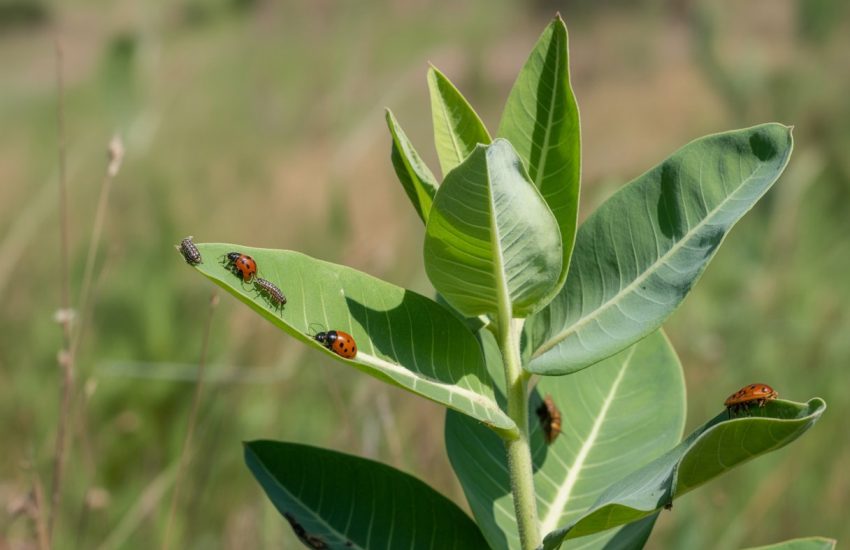10 Ground Cover Plants to Grow in Washington State
Ground cover plants are a staple in many gardens and landscapes across the country. However, when selecting a ground cover plant for your garden, there are a few factors to consider, including if the plant does well in your state’s climate. For those residing in Washington, there are several excellent varieties of ground cover plants that will thrive in the climate and add visual interest to your yard.
Best Ground Cover Plants to Grow in Washington State
1. Blue Nest Spruce

The Picea Mariana, known as the Blue Nest Spruce, is an evergreen plant commonly used as groundcover in the Pacific Northwest. This evergreen plant is a dwarf conifer. Dwarf conifers are highly valued in the gardening and landscaping communities for their globe shape and ornamental properties.
Upon reaching maturity, the Blue Nest Spruce is around 4 feet in height and 5 feet in width. The plant is low maintenance, requiring only occasional trimming of the season’s new growth. Blue Nest Spruce grow at a slow rate and, under the right conditions, can live for upwards of 50 years.
This plant thrives in US hardiness zones 2 through 7 and requires full to partial sun (4 to 6 hours of direct sunlight per day). During the plant’s youth, it needs moist soil, and the soil cannot dry out. After reaching a more mature age, the plant will do best in rich soil but will also tolerate poor soil. The Blue Nest Spruce works well as ground cover but can also be used as a border in rock gardens and planted in containers.
2. Bunchberry
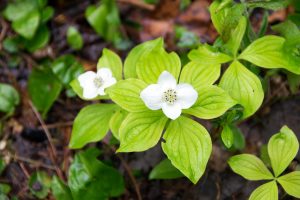
The Bunchberry plant, formally known as Callicarpa Dichotoma x Kwangtungensis, is an advanced hybrid of two plants, one of which belongs to the mint family. The Bunchberry is highly sought after due to the showy violet pearls it bears and its dark purple leaves.
During the spring, the plant blooms white flowers, which attract a variety of wildlife, such as bees and other insects. In the fall, the violet berries are on full display. These berries have a high moisture content and are a source of food for over 40 bird species.
Bunchberry plants reach a mature size of 2 to 4 feet in height and 3 to 5 feet in width. The plant thrives in US hardiness zones 5 through 8 and requires full sun to partial shade. Bunchberry plants should be planted in soil with good drainage. The Bunchberry’s showy flowers begin blooming in the spring and continue to bloom through summer before giving way to the showy purple berries. These berries bloom through fall and begin falling off the plant in the winter. This plant is also resistant to native deer populations, making it an excellent addition to most gardens as ground cover, borders, and hedges.
3. Carpet Bugle
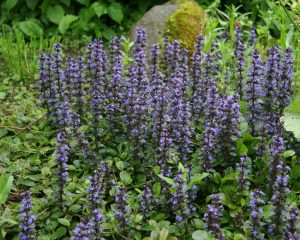
Ajuga Reptans, the Carpet Bugle, also called Bugleweed, is a semi-evergreen to evergreen ground cover plant. Carpet Bugle is a perennial member of the mint family. The plant is known for its dense, compact mat and small clusters of purple flowers. This plant’s dense mat allows it to smother weeds, but it is important to give the Carpet Bugle space away from other perennials and flowers as they, too, will be smothered.
The Carpet Bugle can reach 6 inches to 1 foot in height and 6 inches to 1 foot in width. This plant is tolerant of all light levels, from deep shade to full sun (less than 2 hours of sun to 6 or more hours of direct sun per day). Carpet Bugles can be planted in clay, loam, sand, and soil with good drainage or occasionally wet soil.
This plant does well in US hardiness zones 3 through 10, making it a popular choice among gardeners across the US. The Carpet Bugle bears white, blue, and purple/lavender flowers from early spring to summer. As fall approaches, each flower is replaced by nutlets. These nuts are on display and can be harvested during autumn.
4. Creeping Alpine Willow
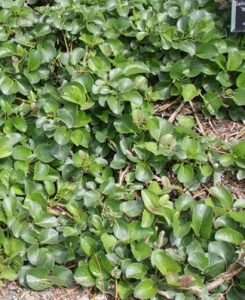
Unlike most willow varieties, the Creeping Alpine Willow is a creeping, prostrate shrub. The Creeping Alpine Willow is also referred to as the Yezo Dwarf Willow. This plant has heart-shaped leaves, unusual yellow catkins, and silver flower buds. The plant’s foliage is highly ornamental, turning from bright green in the summer to gold in the fall.
Creeping Alpine Willow is recommended for ground cover, general garden use, mass planting, and rock garden use. At maturity, the plant will be approximately 6 inches tall with a 24-inch spread. The Creeping Alpine Wilow grows at a medium rate and, under the best and most ideal conditions, can live for 30 years.
This shrub is low maintenance, only requiring occasional pruning and upkeep in the winter months. Creeping Alpine Willow grows best in US hardiness zones 4 through 8 and requires full sun to partial sun.
5. Creeping Mahonia
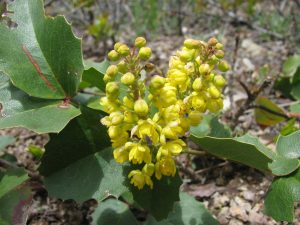
Berberis Aquifolium, called Creeping Mahonia, Oregon Grape, or Oregon Holly, is a medium-sized evergreen shrub commonly used as a garden ground cover plant. The plant is a slow growing perennial that bears fragrant gold and yellow flowers in the springtime.
A mature Creeping Mahonia plant can grow to 3 to 10 feet in height and has a spread of 2 to 5 feet. Creeping Mahonias do best in US hardiness zones 5 through 9 and require full sun to partial shade (between 2 to 6 hours of direct sunlight per day). The soil where Creeping Mahonias are planted should have good drainage and be neutral to acidic in pH (a pH of less than 6.0 to 8.0).
The Creeping Mahonia plant is well-known for bearing both flowers and edible berries. During spring, you can expect the Creeping Mahonia to blossom with mildly fragrant yellow and gold flowers. These flowers are between 1 to 3 inches in size. These flowers give way to edible blue, black, or green berries when the summer and fall months begin. These small berries, less than 1 inch in size, are known as edible globose berries.
6. Chinese Stonecrop
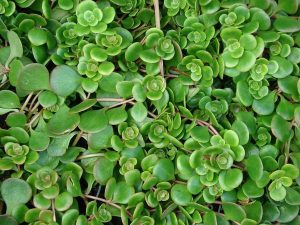
Sedum Tetractinum, the Chinese Stonecrop, is an evergreen herbaceous perennial succulent. This ground cover plant has a medium growth rate and is low maintenance. This plant native to Southeastern China is valued for its attractive flowers and pollinator attraction.
In the months of July and August, small pink and white flowers blossom on the Chinese Stonecrop. These flowers are ornamental and star-shaped. After the flowers have finished blooming, capsule-shaped fruit begins to grow on the plant. The fruit of the Chinese Stonecrop is less than 1 inch both in width and length.
Upon reaching maturity, the Chinese Stonecrop is approximately 3 inches tall and 12 inches wide. Thriving best in US hardiness zones 4 through 8, the Chinese Stonecrop requires full sun to partial shade. The soil where the Chinese Stonecrop is planted should be neutral or alkaline (having a pH of 6.0 or higher). However, the plant is tolerant of poor soil, dry soil, and drought so that the soil can be very dry to moist. The plant is also resistant to rabbits, erosion, and deer.
7. Dwarf Greek Oregano
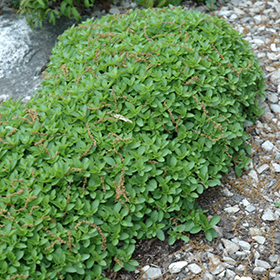
Dwarf Greek Oregano is an evergreen herb often used as ground cover. The herb is a perennial and is valued for its ornamental and edible qualities. During the summer, small pinkish violet flowers bloom on the Dwarf Greek Oregano plant. The leaves of the plant are highly aromatic and are great for cooking and seasoning.
Aside from its most common use as an herb, this plant is often used as ground cover, border edging, in rock gardens, and as a container plant. Its full mature height is 8 inches with a spread of 18 inches. Dwarf Greek Oregano requires full sun (6 or more hours of direct sunlight per day) and thrives in US hardiness zones 5 through 10.
8. Crinkle-leaf Creeper
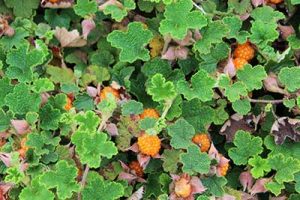
The Rubus Hayata-koidzumii plant, commonly known as Crinkle-leaf Creeper, is a perennial ground cover plant. Like the plant’s name, the Crinkle-leaf Creeper suggests spreading by creeping. Crinkle-leaf Creeper is a low-maintenance evergreen plant with a medium growth rate. The most common use of this plant is as a ground cover plant in gardens, but this plant is also frequently used for mass planting and container planting.
At full maturity, the Crinkle-leaf Creeper has an average height of 1 to 3 inches and a spread of 4 to 6 feet. The leaves of the plant quickly form a dense carpet as the plant begins to spread. Due to his mature spread of 4 to 6 feet, it is best to leave about 6 feet between this plant and any other plants you have in your garden.
Crinkle-leaf Creeper thrives best in US hardiness zones 7 through 9. This plant is tolerant of most light levels: dappled sunlight, partial shade, and full sun. When planting Crinkle-leaf Creeper, the soil should have good drainage and a shallow, rocky texture for the best growth results. This plant is resistant to heat, erosion, dry soil, and deer.
During the spring and summer months, the plant bores small white flowers. However, they are not prominent and are often lost within the plant’s foliage. Crinkle-leaf Creeper plants produce small (approximately half an inch) gold/yellow, orange, and red/burgundy fruit.
9. Hardy Ice Plant
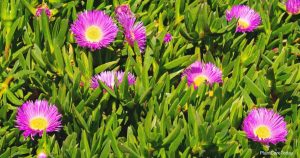
Delosperma, the Hardy Ice plant, is a flowering ground cover plant frequently used for garden edging and borders. The Hardy Ice plant is a perennial native to Africa, Yemen, and Saudi Arabia. The plant has spreading properties and grows at a medium rate.
One of the biggest selling points of the Hardy Ice plant is the various colors of flowers produced by the plant. This plant’s flowers bloom from June to October and come in many shades, including yellow, pink, purple, red, and white. These showy flowers are around 1 to 2 inches in size and are perfect for those looking to add interest to their garden.
The Hardy Ice plant is a low-lying plant, only reaching 1 to 3 inches in height. Although the plant spreads, it typically stays around 1 foot in width. The plant does best in US hardiness zones 5 through 8 and requires full sun (6 hours of direct sunlight per day). The soil where the Hardy Ice plant is planted can be shallow, rocky, sandy, very dry, occasionally dry, or have good drainage. This plant is drought and heat tolerant and will attract bees and butterflies to your garden.
10. Moneywort
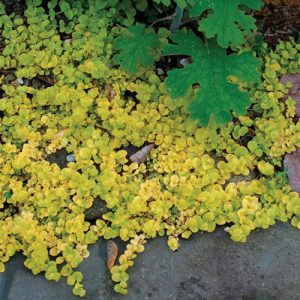
Lunaria Annua, the Moneywort, is a herbaceous perennial. The maintenance level for Moneywort is medium, and the plant has a rapid growth rate. The Moneywort plant is native to Europe. While this plant makes an excellent ground cover plant for gardens, it is important to note that Moneywort is a weedy plant. This means that once you plant Moneywort in your garden, it will be there forever. Due to this, the plant is considered invasive in some areas.
During the spring, Moneywort bears showy, fragrant pink, purple, or white flowers. These flowers are saucer-shaped and less than 1 inch in size. Mid-summer fruits will begin to appear on the Moneywort plant. The fruits of the Moneywort are silver dollar sized and resemble a full moon. Gardeners like the Moneywort’s fruit because they are good both dried and cut.
The Moneywort thrives in the US hardiness zones 5 through 9 and requires full sun to partial shade. The soil where Moneywort is planted should be high in organic matter and moist/have good drainage.


